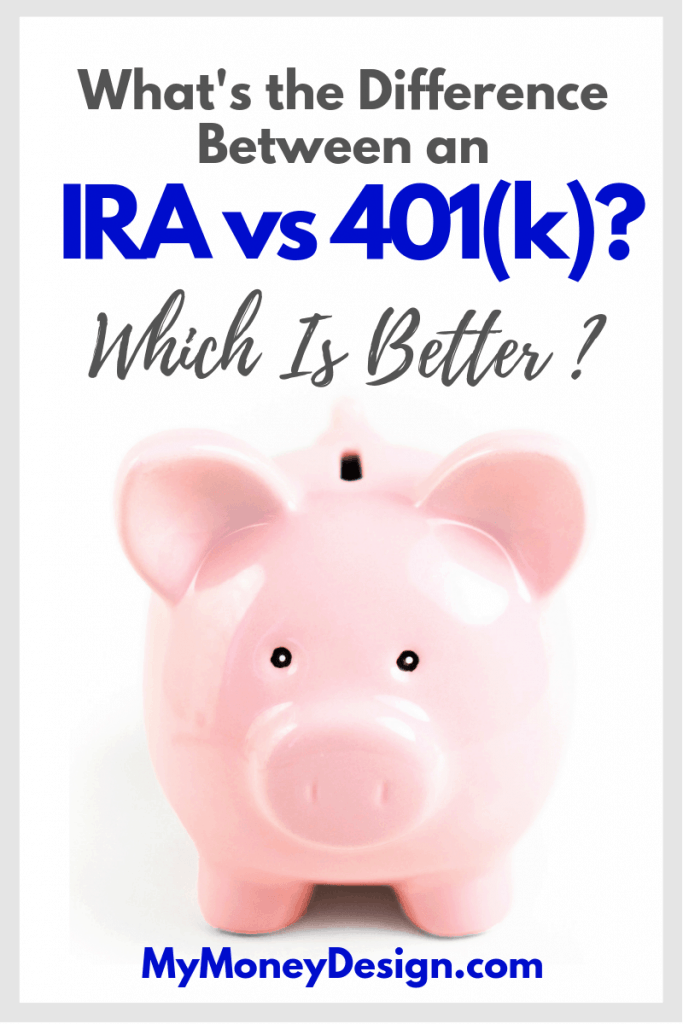
If you’re curious to find out what’s the difference between an IRA and 401(k) retirement plan, then this is the post that is going to explain everything you need to know!
For most U.S. employees, when it comes to saving for retirement, they are offered two main tools to work with: A 401(k) and IRA.
Though a lot of people will likely have the opportunity to contribute to both, sometimes the amount of money you plan to set aside for retirement each month can be limited by all the other financial demands going on in your life. That’s when you might find yourself having to choose between one or the other.
So then, what do you do? Which retirement plan do you choose to stash your savings in hopes that it will grow to its maximum potential?
There are definitely some unique advantages to using one or the other. For example, 401(k) plans have higher contribution limits making them more attractive for savers who set aside a higher percentage of their income.
But if you need to pull some of your money out of your retirement funds to cover a life emergency, then you might find that an IRA will give you less obstacles to work around.
If you’re an early retirement seeker like myself, both types of plans can also offer some useful tricks that will enable you to get access to your money before the IRS minimum age requirement.
Here are some of top questions you might have about the differences between a 401(k) and IRA, and how each one may provide you with some advantage in your retirement planning. Enjoy!
How an IRA vs 401(k) Works – The Tax Savings!
Advantage: BOTH!
One clear benefit to using either a 401(k) or IRA is that they both give you the chance to save your money before taxes are taken out.
Take the traditional 401(k) for example. Let’s say you’re in the 22% tax bracket. For every $1 you earn, you already know you’re going to lose roughly 22 cents to taxes.
But when you opt instead to put that $1 into the 401(k) plan, the whole dollar moves to it. It won’t be taxed until decades later when you finally decide to retire.
Though these tax savings might not sound very significant, it works out to a whooping 28% more money saved than if you had tried to save your money post-tax in a regular bank savings account! That’s a big deal!
With a traditional IRA, the mechanics are a little different, but the end result is basically the same. You make your contributions to an IRA throughout the year without the immediate tax deduction and then declare them at the end when you file your Federal tax return. The total is subtracted from your income and then the tax deduction is realized, thus resulting in the same end goal.
Contribution Limits
Advantage: 401(k)
When it comes to “how much you’re allowed to save”, 401(k)’s are clearly the front-runner. According to the IRS, as of 2019 you are allowed to save up to:
- 401(k) = $19,000 per year
- IRA = $6,000 per year
Remember that since you’re saving roughly 22 cents in taxes for every dollar you contribute, that higher limit could mean big savings for you! Consider that hitting the maximum contribution would mean:
- 401(k) = $4,180 in taxes saved
- IRA = $1,320 in taxes saved
If you’re age 50 and over, the same goes for Catch-Up Contributions. 401(k)’s will let you add an extra $6,000 whereas IRA’s only let you contribute another $1,000 on top.
It’s because of this tax savings that when people ask me “How much should I contribute to my retirement plan?“, my answer is always the same: All the way up to the IRS limit!
Contribution Eligibility
Advantage: IRA
While the 401(k) has become one of the most popular types of retirement plans available, it is still fundamentally a “work-place” plan. This means your employer has to offer one in order for you to participate. Unfortunately, according to Bloomberg this means that 1 out of 5 workers ends up getting left out in the cold.
By contrast, an IRA is an “individual retirement arrangement”. This means it is a retirement plan that you start and manage yourself. All it takes to get started is going online or making a phone call with any brokerage of your choice.
The main requirement of being able to contribute to an IRA is that you need to have earned some taxable income this year. But there is one small catch: Your contribution may or may not be tax-deductible depending on your income level, filing status, and contributions to other retirement plans. The best way to know for sure is to have a look over the official IRS eligibility requirements.
Employer Matching Contributions
Advantage: 401(k)
Employer matching contributions are another huge advantage of using your 401(k). Most employers who offer them will also offer some sort of match; the most common being 50 cents for every dollar you contribute.
Unfortunately with IRA’s, this would be rare – if ever done at all. Because the IRA is something you manage, employers don’t typically get involved.
Honorable mention for the IRA: If you earn money on the side or are self-employed, than participating in something called a SEP IRA can be a huge benefit to your taxes. I do this every year, and it not only lowers my tax burden, but allows me to stash away another $3,000-$4,000 away for retirement. That’s on top of any other 401(k) or IRA contributions I’ve already made!
Investments
Advantage: IRA
IRA’s are great because YOU get to choose who and what you’d like to invest in. That means you could go to a broker that offers mutual funds, ETF’s, stocks, bonds, etc. But it could also mean that you include other alternative assets like real estate or precious metals.
Unfortunately with a 401(k), you’re stuck with whatever funds your employer is offering. Case by case, this could be either really good or bad. I’m very fortunate to work for a company that uses Fidelity for their 401(k) plan, and they offer more funds than I could ever care to choose from. But I’ve also heard horror stories of employers who go through some less creditable brokers and offer some very poor fund choices.
To know if you’re 401(k) fund choices are on par with the rest, look at 1) the performance of the funds and 2) the expenses. There should be at least a few funds that compare in performance to that of a simple stock market index fund (returning roughly 10% per year). The expense ratios should also be less than 1%. Less than 0.5% would be even better.
Roth-Style Accounts
Advantage: Both (IRA slightly better)
If you prefer the setup of a Roth-style retirement savings plan, than you’re usually in luck! Most of the time, both types of accounts are offered.
Recall that a “Roth” style plan means you enjoy the tax benefit later in life (when you retire) instead of right now. Consider the IRA for example. With a Roth-style IRA, you’d pay your taxes now, and then enjoy tax free income on whatever your savings had grown to in the future. It basically is choice between: Do you want to pay the taxes now or later?
For a lot more information on Traditional vs Roth plans, please read my detailed post here.
So why is the IRA slightly better in this area?
Because if you wish to contribute to a Roth-style IRA plan, its very easy! Assuming you’re underneath the necessary income retirements (most middle class Americans are), all you have to do is simply check the box next to which plan you’d like (i.e. traditional or Roth) when you’re signing up online with your favorite financial service provider. Done!
With a 401(k), it all depends on whether or not your employer-sponsored plan offers this option. If they do, then great! If they don’t, then you’re out of luck.
Fees
Advantage: IRA (usually).
Again, because your employer dictates which funds you can pick from in the 401(k) plan, you’re somewhat stuck paying whatever the broker charges.
But on top of that, 401(k) funds also usually charge some sort of administrative fee. This is a sort of “overall” fee simply for managing the plan. Depending on how much of this expense your employer absorbs, this fee could impact your net savings rate as well.
By contrast with IRA’s, because you can choose where you start them, this means you have the freedom to select a low cost provider like Vanguard or Fidelity. Funds there can cost as low as $5 for every $10,000 invested. Plus, there are usually not any administrative fees since the tracking is all part of their normal paperwork tracking.
Withdrawals
Advantage: Generally the same.
For the most part, the IRS stipulates that you must be age 59-1/2 to start making withdrawals from your retirement accounts. Otherwise, there will be a hefty 10% penalty to pay on top of the taxes you owe.
However, there are a few exceptions to this rule:
Loans:
Advantage: 401(k). If your employer allows you, you can take a sizeable loan from your 401(k) to help cover emergencies. You’ll have 5 years to pay it back. With IRA’s, the term is much shorter limited to just 60 days.
Early Retirement (Less Than 5 Years):
Advantage: 401(k). If you plan to retire by age 55 or older, 401(k)’s offer you a special exception known as the Age 55 Rule where you can start taking your money out early penalty-free. IRA’s do not offer this.
Early Retirement (5 or More Years):
Advantage: IRA. If you plan to retire much sooner than your peers, than you will need to be very strategic about how you withdraw your money. This will usually involve taking out a 72t or making Backdoor Roth IRA Contributions. Both of these strategies will be much easier to execute if you do them inside your IRA instead of your 401(k).
Conversions / Rollovers
Advantage: Generally the same; IRA’s are easier.
For most financial companies, conversions and rollovers are no problem for both IRA’s and 401(k)’s.
For example, when I moved from one employer to another, I was able to transfer my old 401(k) into our IRA with nothing more than a phone call and a few online forms.
Moving from a traditional to a Roth style account is also very simple. However, be aware that there could be BIG tax implications if you do this. For example, if you’ve got $100,000 that you’d like to move into a Roth, remember that you’d have to pay the taxes now. That means you’d owe approximately $22,000 (or more) to do this! Consult expert advice first!
As we’ve mentioned with 401(k)’s, your employer’s plan has to allow these sorts of things in order for them to occur. This will vary case to case.
With IRA’s, the decision is all yours. That makes it much easier to do.
Required Minimum Distributions
Advantage: Same.
The IRS isn’t going to let you keep your money in tax-deferred accounts forever. Starting at age 70-1/2, they will start making you take something called “required minimum distributions” or RMD’s. Basically its a way of forcing you to start taking more money out and paying the IRS back for all the taxes you’ve deferred for so long.
If you don’t, there are VERY serious penalties to pay! How serious? Try 50% of the difference between what you took out relative to your RMD.
This will apply to both your traditional 401(k) and IRA. If you elected either to be Roth-style, then RMD’s are not required since you’ve technically already paid taxes on this savings.
Beneficiaries
Advantage: Same.
Fortunately when it comes to passing on your hard-earned fortune, the IRS makes it easy for you to do the same thing with each type of account.
If you have a spouse, it can simply be transferred over to them, and it will be treated as if it was their own.
If you leave either to someone else, then similar to RMD’s, your beneficiary will be required to start making mandatory withdrawals from the account each year (with taxes paid as well).
Readers – What are the differences between an IRA vs 401(k) that you find to be the most important? What are some of the benefits or disadvantages that you’ve experienced using one versus the other?
Photo credits: Flickr, Unsplash






Maxed out the 401K every year I worked plus a Roth for the years I was eligible and a post tax regular IRA for the years I wasn’t plus another 15% into regular brokerage accounts. And now I do what I want while my old work buddies are still at the plant. Had a nice seven figure balance on just the 401k alone when I walked away! The 401k had a 6% match which made it really nice and it had low cost index funds also.